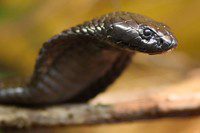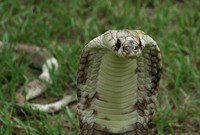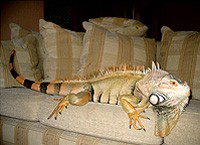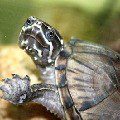
Egyptian cobra
EGYPTIAN COBRA (Naja haje) or Gaia, also known as the real asp. This large snake, up to 2 m long, is distributed in Africa north of 15 ° S. sh. and on the Arabian Peninsula. Most of the time this snake spends on the ground, but sometimes it climbs trees or swims. In case of danger, the snake takes a defensive posture characteristic of all cobras, but its extended neck “hood” is noticeably narrower than that of the Indian cobra. The Egyptian cobra is often used by snake charmers in their street performances. In captivity, the Egyptian cobra lives well, immediately taken for food, preferring small birds and mice.
Classification
 Kingdom: Animalia (animals)
Kingdom: Animalia (animals)
Type: Chordata
Class: Reptilia (reptiles)
Order: Squamata (scaly)
Suborder: Serpentes (snakes)
Family: Elipidae (aspididae)
Genus: Naja (real cobras)
Species: Naja haje (Egyptian cobra)
Inhabitation
Most often, you can meet the Egyptian cobra in Northeast Africa, less often in the northwest and east of the mainland, on the Arabian Peninsula. In the tropical forests of West Africa, it is absent. It is located in the steppe and desert areas, in the mountains, near villages, on cultivated lands. Most often he chooses for himself areas with an abundance of shelters, with ruins, bushes or stone mounds, he loves termite mounds very much.
Description
 This is a large snake up to 2 meters long.
This is a large snake up to 2 meters long.
The coloration of adults is usually single-colored, from light yellow to dark brown. The ventral side is lighter. There are several dark, wide stripes on the underside of the neck, which are clearly visible when the snake assumes a threatening posture. You can also find striated specimens, the body of which will be decorated with wide light yellow and dark brown bandages.
Very shy, it always basks in the sun near its habitat, in order to quickly hide in a shelter in case of danger.
Most of the time the cobra spends on the ground, but sometimes swims or climbs trees. In case of danger, the snake assumes a defensive posture, characteristic of all cobras, however, the Egyptian cobra has an extended cervical “hood” that is noticeably narrower than, for example, that of the Indian cobra.
The venom of the Egyptian cobra contains potent toxins that affect the peripheral nervous system. However, it does not affect the brain. A person bitten by an Egyptian cobra clearly feels his breath stop. After breathing stops, it may take about half an hour until the moment of loss of consciousness and cardiac arrest.
Food
The Egyptian cobra hunts most often in the evening and at night. The main diet consists of amphibians, rodents, birds and their eggs, lizards and other snakes.
Reproduction
The Egyptian cobra is oviparous. For one clutch, she lays 8-20 eggs. The incubation period is approximately 60 days. Young individuals are born about 20-35 cm long. After 7-12 days, young cobras molt and, after the first skin change, begin to feed.
Content
In captivity, the Egyptian cobra lives well, immediately begins to eat, preferring small birds and mice. In winter, it usually falls into a lethargic state and refuses to eat. The rest of the time she leads an active lifestyle – she will need a spacious terrarium. It is better not to keep several individuals in one terrarium – conflicts over food are possible, which can lead to a sad outcome – the death of one of the individuals.
Additionally
Among the Egyptians, this cobra was considered a symbol of power. Her image adorned the headdress of the pharaohs.
In ancient times, her bite was used in what seems to be a “mercy” – a substitute for a public execution.
Based on research by specialists from the Department of Biochemistry at Aya Shams University, the venom of the Egyptian cobra can destroy the structure of cancer cells. It deforms cancer cells, contributes to the appearance of cracks on their walls and the disintegration of the cytoplasm.
The Egyptian snake is also called a true asp.
Sources of
http://www.diary.ru/~snakenest
http://www.megabook.ru
http://www.canadets.com
http://www.rentokileesti.ee/ru
http://www.floranimal.ru
http://www.kobri.narod.ru
http://dic.academic.ru
http://www.povodok.ru





